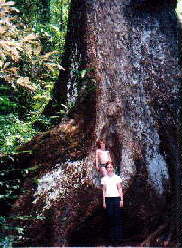Giant Red Cedar Tree

The Giant Red Cedar Tree:
-
The Red Cedar is an important tree in the history of Australia.
-
Affectionately known by the Australian settlers as ‘Red Gold’, this tree was the
pulling motivational factor that caused the settlement of much of the coastal and
hinterland areas of the country.
- This is the largest accessible Red Cedar Tree remaining in north Queensland and
possibly Australia.
- This Red Cedar is claimed to be the largest in the Southern
Hemisphere.
- A majestic tree, it is well worth the short drive from Chambers Wildlife Rainforest Lodge into the
Gadgarra forest to view this awesome specimen that is considered a soul survivor of a time
long gone, when these Red Giants dominated the forests of the Atherton tableland.
- To get to the Giant Red Cedar from The
Chambers, turn left out of the front
driveway and then first left onto Winfield Road.
- Continue on for 2 km (avoid going down
Day Road) to the crest of the hill where you turn right onto a dirt road and follow the
road signs to the Giant Red Cedar.
- Red Cedar trees are famous for their wonderful timber and for the speed at which
they disappeared after European arrival.
- They are not so well known as fast-growing,
handsome shade trees.
- Their leaves turn yellow in winter and drop off, but within weeks
the new pink shoots will have appeared.
- They were formerly common in the Illawarra region
in New South Wales to the McIlwraith Range on Cape York Peninsula, growing in most
rainforests on fertile soils.
- It also occurs in New Guinea.
- They can be grown in full sun
if given adequate moisture, fertiliser and protection from heavy in the first 2 years.
-
Many of these trees are now being planted privately for reforestation.
- Seeds can be
gathered in December or January as the capsules begin to open and germinate within 2 or 3
weeks.
Giant Red Cedar:
Red Cedar features significantly in Australia's history.
Many costal districts and hinterland districts were founded through the search
for this valuable timber tree. The industry operated through most of this
century and supported the livelihood of many early settlers.
In 1881, timber getters came to the Atherton Tablelands in search of red cedar,
commonly referred to as "Red Gold". The early pioneers used red cedar
extensively and saw the rainforest as an endless resource.
The magnificent tree featured in the photograph above, is believed to be the
largest, accessible red cedar remaining in North Queensland and possibly
Australia.
|
